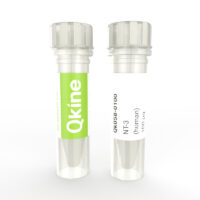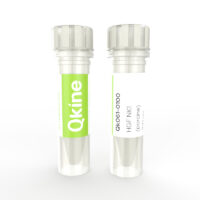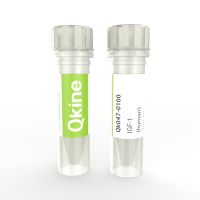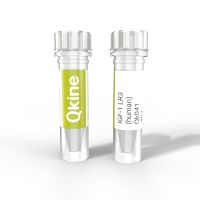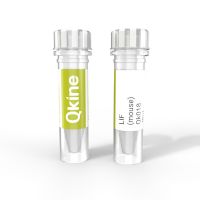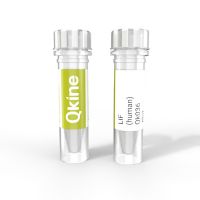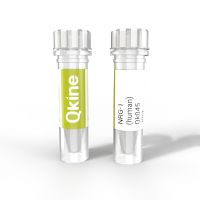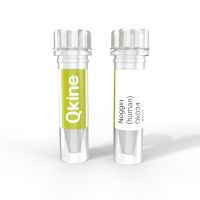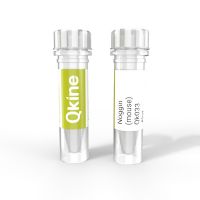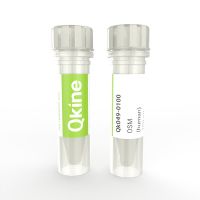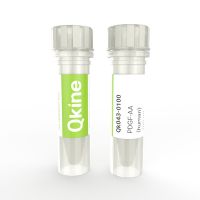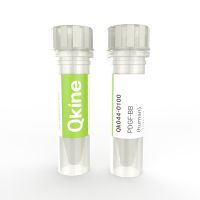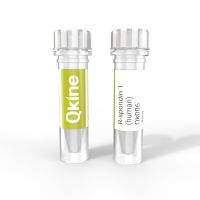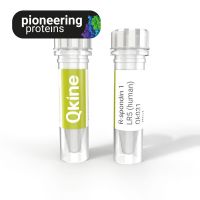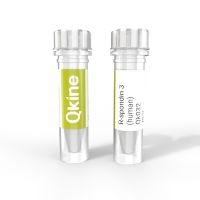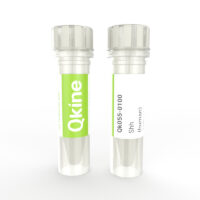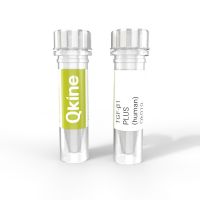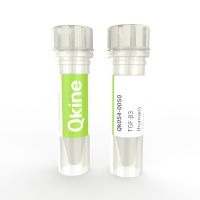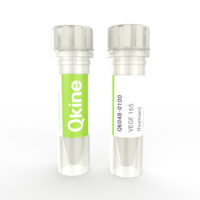- Neurotrophin 3 protein is part of the neurotrophin family and plays a crucial role in embryonic development and the maintenance and neuroprotection of the adult nervous system.NT-3 protein is used in cell culture to promote the differentiation and survival of specific neural subpopulations in both the central nervous system and peripheral nervous system such as sensory neurons, cortical neurons, and oligodendrocytes. It is also involved in the maintenance of endothelial cells and myocardial cells.Recombinant Neurotrophin 3 protein is a non-covalently linked homodimer with a molecular weight of 27.3 kDa.Qkine NT3 protein is animal-free (AOF), carrier-free, tag-free, and non-glycosylated to ensure its purity with exceptional lot-to-lot consistency. It is suitable for the culture of reproducible and high-quality cortical neurons and oligodendrocytes.
- Recombinant porcine HGF protein is a potent, high-purity NK1 isoform of porcine hepatocyte growth factor (HGF). Porcine Recombinant Protein HGF differs from human HGF at several key amino acid residues that are predicted to affect bioactivity and receptor binding. Use of species-specific HGF growth factor will facilitate media optimization for cellular agriculture (cultivated meat) and veterinary applications. Also available is Qk060 Bovine HGF (NK1). The highly scalable animal-free manufacture and enhanced bioactivity make this suitable for chemically-defined media and reproducible scale-up.20kDa naturally occurring isoform of HGF, animal-free and carrier-protein free.
- Human IGF-1 protein (IGF-I), insulin-like growth factor 1, is used in the maintenance of human pluripotent stem cells and is necessary for cell growth in the absence of insulin1. IGF-1 promotes the proliferation of many cell types, including mesenchymal stem cells, in vitro.Highly pure and bioactive 8 kDa IGF-1 protein, animal-free (AF) and carrier-protein free (CF)
- Human IGF-1 LR3, insulin-like growth factor long arginine 3, protein is a synthetic analog of IGF-1. The substitutions include an Arginine substitution and an N-terminal protein extension. Consequently, IGF-1 LR3 has improved biological potency and extended half-life.Highly pure and bioactive 9 kDa IGF-1 LR3 protein monomer, animal-free (AF) and carrier-protein free (CF). IGF-1 LR3 is often used in the maintenance of human pluripotent stem cells [1].
- Mouse LIF (murine leukemia inhibitory factor) protein maintains the pluripotency and self-renewal of mouse embryonic and induced pluripotent stem cells. Qkine recombinant mouse LIF protein is animal-free and carrier-protein free for highly reproducible results. Bioactivity was tested by colony formation assay and determination of Nanog expression.1
- Human LIF (leukemia inhibitory factor) protein suppresses the differentiation of murine embryonic stem cells (ESCs) and is widely used in ESC and iPSC culture.1 Qkine human LIF protein is high purity and animal and carrier-protein free for reproducible results.
- Human NRG-1 protein (Neuregulin 1) is frequently used in the maintenance of human pluripotent stem cells. In addition to its widespread use in stem cell culture media, NRG-1 (also known as Heregulin-β1 , HRG-1) has essential roles in vivo including in nervous system, cardiac, and mammary gland development; cancer biology and neurological disorders.7.5 kDa highly pure, bioactive domain of human NRG-1, comprised of the β isoform of the EGF-like domain of NRG-1 (HRG1-B1). This NRG-1 protein monomer is animal-free (AF) and carrier-protein free (CF).
- Human noggin is a bone morphogenetic protein (BMP) family antagonist used in the culture of intestinal, pancreatic, lung and tumor-derived organoids, maintenance of undifferentiated embryonic stem cells and for stem cell differentiation into neural and microglial lineages.Qkine human noggin protein is a highly pure 46kDa bioactive dimer for reproducible results in organoid culture.
- Mouse/rat noggin is a bone morphogenetic protein (BMP) family antagonist used in the culture of intestinal, pancreatic, lung and tumor-derived organoids, maintenance of undifferentiated embryonic stem cells and for stem cell differentiation into neural and microglial lineages.Qkine recombinant mouse noggin protein is a highly pure 46kDa bioactive dimer for reproducible results (animal-free and carrier-protein free).
- Human OSM protein (oncostatin M) is used in the differentiation of human pluripotent stem cells into hepatocyte-like cells. OSM also plays roles in osteogenesis and neurogenesis, and is an important regulator of the hematopoietic stem cell niche in the bone marrow. Qkine human oncostatin M protein is high purity and animal and carrier-protein free for reproducible results.
- Human PDGF-AA (platelet derived growth factor AA) protein is a homodimer of PDGF-A peptide chains. This protein is a potent mitogen involved in embryogenesis.1 PDGF-AA is commonly used to differentiate human pluripotent stem cell (hPSC)-derived neural progenitor cells into oligodendrocyte precursor cells.2High purity 29 kDa disulfide–linked bioactive dimeric human PDGF-A protein. Animal-free (AF) and carrier protein-free.
- Human PDGF-BB (platelet derived growth factor BB) protein is a homodimer of PDGF-B peptide chains. PDGF is a potent mitogen involved in embryogenesis.1PDGF-BB is used in neuronal differentiation2 and treatment of periodontal and orthopedic bone defects and dermal wound healing.3High purity 25 kDa disulfide–linked bioactive dimeric human PDGF-B protein. Animal-free (AF) and carrier protein-free.
- R-spondin 1 protein (RSPO1) is the prototypic member of the R-spondin family and is used to potentiate Wnt signaling in many organoid culture systems including intestinal and tumor (cancer) organoid culture. R-spondin 1 is also required for hematopoietic stem cell specification and cancer cell migration and survival.Recombinant human R-spondin 1 protein (RSPO1) protein is the bioactive domain of human R-spondin 1 comprising the two cysteine-rich furin-like domains of R-spondin 1. Those are necessary and sufficient for Wnt signaling potentiation and are the essential domains for activity in stem cell and organoid culture.This protein has a molecular weight of 13 kDa and is animal-free, carrier protein-free, and tag-free to ensure its purity with exceptional lot-to-lot consistency. Qk006 is suitable to replace R-spondin conditioned media for improved reproducibility in chemically defined organoid culture media.
- Recombinant human r-spondin 1 LR5 protein is engineered to act as a high affinity ligand for the LGR5 receptor. In epithelial tissues LGR5 marks the stem cell population. This engineered protein, R-spondin 1 LR5, activates wnt signalling only in the LGR5+ stem cell population. R-spondin1 LR5 has been tested in intestinal organoid culture and supports organoid survival and growth. As LGR5 specifically marks stem cells and is not found on transit amplifying cells, the lower crypt multiplicity seen in organoid cultures with R-spondin 1 LR5 (in comparison to wild-type R-spondin 1, Qk006) supports the notion that this engineered form is acting specifically on stem cells. This specialized form of R-spondin 1 was developed in Marc de la Roche’s lab (University of Cambridge).
- Human R-spondin 3 protein potentiates Wnt signalling in and has been shown to function in crypt regeneration in the intestine and control stem cell and progenitor cell behaviour during kidney development. R-spondin 3 is used alongside R-spondin 1 in intestinal organoid culture systems.17kDa highly pure, bioactive domain of human R-spondin 3 comprising the two cysteine-rich furin-like domains, which are necessary and sufficient for Wnt signalling potentiation and are the essential domains for activity in stem cell and organoid culture. Animal-free and carrier-protein free.
- Sonic hedgehog protein (Shh) is a member of the Hedgehog family with an essential role in embryonic development, tissue regeneration, and tumorigenesis. Shh induces the cell fate and patterning of neural progenitors in ventral domains at various levels in the forebrain, midbrain, hindbrain, and spinal cord. It has many applications in the neural stem cell field where it plays a significant role in differentiating human-induced pluripotent stem cells (iPSC) towards motor neurons and interneurons. Also, it induces the patterning of organoids and embryos in culture.Recombinant Shh protein has a molecular weight of 19.8kDa. This protein is animal-free (AOF), carrier protein-free, and tag-free to ensure its purity with exceptional lot-to-lot consistency. Sonic hedgehog protein is suitable for the culture of reproducible and high-quality neurons and organoids.
- Transforming growth factor-beta 1 (TGF-β1) is a pleiotropic cytokine that regulates various cellular processes, including cell proliferation, growth, differentiation, motility, and apoptosis. It is an essential growth factor in many embryonic and induced pluripotent stem cell maintenance media, including the commonly used E8, StemPro, and mTeSR media. TGF-β1 also promotes the differentiation of various cell types such as fibroblasts, epithelial cells, and immune cells.Human/bovine/porcine recombinant TGF-β1 PLUS protein is the first entirely animal-free recombinant human TGF-β1 protein for highly reproducible results and compatible with chemically-defined stem cell media.TGF-β1 PLUS is a high purity 24 kDa dimer comprising optimized mature domain of TGFβ1 protein, animal-free (AF) and carrier-protein free (CF). Our TGF-β1 PLUS protein has been extensively tested for maintenance of iPSC pluripotency by the specialist stem cell biotechnology company, Stemnovate, Cambridge, UK.*Benchmark our TGF-β1 PLUS against your existing supplier*
- Human TGF-β3 protein is a member of the Transforming Growth Factor family, a family involved in regulating cell survival, proliferation and differentiation.1 TGF-β3 is used in human pluripotent stem cell maintenance medias, such as B8 media.2 High purity and bioactivity for reproducible results. Human TGF-β3 protein dimer, animal-origin free (AOF) and carrier-protein free (CF).
- Recombinant human vascular endothelial growth factor 165 (also known as VEGF165/ VEGF-165/ VEGF-A/ VEGF165) protein is widely used in culturing primary endothelial cells, such as human umbilical vein endothelial cells.VEGF165 is commonly used with human-induced pluripotent stem cells or embryonic stem cells-derived endothelial cells for developing human vascular tissue models. It has many applications including its use in neural research involving oligodendrocyte precursor cells, Schwann cells, astrocytes, and microglia. It plays a role in bone formation, regulates mesenchymal stem cell differentiation, and serves as a survival factor for chondrocytes, hematopoietic stem cells, and tumor cells.Qkine recombinant human VEGF165 protein is a highly pure and potent 38 kDa homodimer, disulfide-linked consisting of two 165 amino acid polypeptide chains. It is an animal origin free (AOF) and carrier protein-free (CF) isoform of VEGF for high efficiency.
